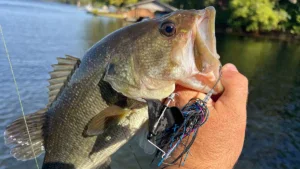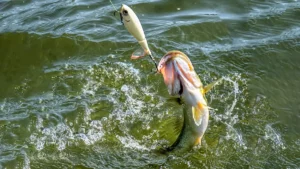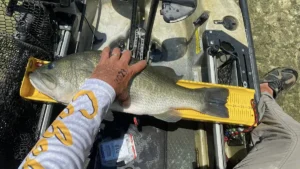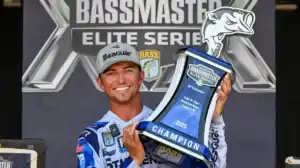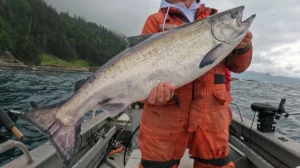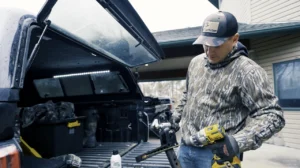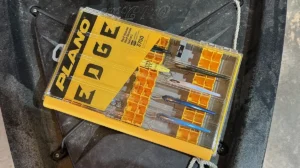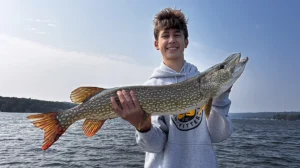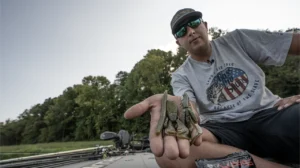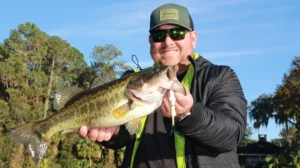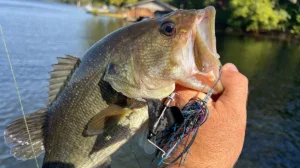April is the most unanimously anticipated month of bass fishing for anglers in the U.S., from one end of the country to the other and as far north and south as you can go. Sure, there are times later in the year when the northern fisheries are even better, and the peak of the spawn in the southernmost states has come and gone by now, but spring is officially here nationwide, and the fish are biting. It’s time to shake off the cabin fever soaked with seasonal depression and get outside, on the water, with a rod in your hand.
I have some suggestions for the South, Elite Series Pro and champion Jay Przekurat brings some insight for anglers in the Midwest, current Elite Series Angler of the Year leader John Garrett talks fishing near his home waters of Kentucky Lake, and Wired2Fish Editor-In-Chief Joe Albanese will chime in on what’s happening in the Northeast: Here’s what we’re fishing with in April.
In the South
Here in Alabama, April is peak spawning season. The same holds true across much of the Southeast and over into parts of Texas, Oklahoma, Nevada, New Mexico, and Southern California. There’s a lot going on in April for anglers in these areas. Some bass are in the final stage of the pre-spawn, feeding up just before they go on their bed. Most bass will bed in April for many of us in this region. And, as soon as they’re done, they’ll be guarding fry and feeding heavily on shad and other baitfish, as they enter into the early post-spawn phase. All of that said, there are lots of techniques that will work.
Floating Worms

Fishing a floating worm is a bit of a lost art form, with so many other baits to choose from these days. For decades, anglers relied heavily on a weightless Texas-rigged trick worm to catch finicky bass. Because of the Senko’s rise in popularity, the trick worm has taken a backseat—several rows back. Add to that the different rigging techniques like drop shots, Neko rigs and wacky rigs, and it makes sense that the floating worm isn’t as popular as it once was.
Still, taking a basic trick worm and rigging it weedless and weightless is a great way to catch finicky bass that are super shallow around the spawn. Some of these fish will not bite an aggressive bait as they go on bed, while they’re on bed and as soon as they come off. But they will eat a floating worm. Slowly twitching this bait back and forth along the surface — or just below it — offers a subtle approach that is still pretty visible. And this bait draws big bites, my dad caught the biggest bass on a floating worm that I personally know of, weighing a touch over 10 pounds.
Wacky Rigs

A wacky rig is a superb bait for April as well, and a good compliment to the floating worm for several reasons. For starters, you can skip a wacky rigged Senko a whole lot better than you can a floating worm, and most other baits for that matter. Having a bait you can skip around the spawn will allow you to put your bait back under cover where late pre-spawners and especially early post spawners like to hangout. As soon as bass fry spawn, they’ll seek refuge under docks, bushes, pontoon boats and the like. The fry guarders are naturally right there with them. So skipping a bait back in these places is a great way to get bit.
The vertical presentation of a wacky-rigged bait also makes it invaluable around the spawn. Bass love to spawn near cover, like dock poles, stumps and rocks. While working baits past these pieces of cover may draw a strike, letting a wacky rig fall slow and vertical by the cover is a much more effective method when the bass are still a little finicky.
Frogs

A frog is my favorite bait to throw in April. It’s one of the first topwaters you can get bit on as the water begins to warm, it’s another bait that you can skip back deep under cover and it catches big ones. I prefer a walking frog early in the month when the bass are more on bed, but will transition to a popping frog later in the month and into May, when the bass are guarding the fry — the spitting action of a popping frog better mimics a threat to the fry.
Choosing the right frog for the job is key. I’ve found no better popping frog than the SPRO Dean Rojas Bronzeye Popping Frog 60. It’s got a stout hook in it, the bait is durable and you can work it two ways—either popping it or walking it. The Bronzeye Poppin’ Frog also has a pretty flat belly, which makes it perfect for skipping. For my April walking frog, I prefer the Strike King Sexy Frog, for a lot fo the same reasons but primarily because it skips better than any other frog I’ve found—again because it has a flatter belly than most other frogs.
Spinnerbaits

For those last few pre-spawn fish staging in shallow brush and other cover, I still love a good spinnerbait. These fish are shallow, aggressive and usually big females. Keeping a spinnerbait on deck allows me to keep that bite honest while I peruse the shallows in search of the first spawners.
On the flip side, a spinnerbait is one of the best baits for catching bass just after the spawn as well. These big females will hunker down in a lot of the same shallow cover just after they come off bed, looking for a big meal to regain their strength. And when the shad spawn gets going, lookout. You can load the boat up with a spinnerbait if you toss it into the mayhem of a good shad spawn.
Poppers

A popper is another stellar bait in April. Early post-spawn bass are again either guarding fry or looking for a substantial meal to recover; in either case, a popper makes for a good offering. You can use bluegill pattern poppers when actively targeting bass that you believe to be guarding fry. But then you’ll want to swap over to more of a shad pattern if you go to target fish around a shad spawn.
Look for shad spawns along some form of hard cover, like docks, riprap, bluffs and seawalls. But don’t neglect vegetation. Shad will spawn heavily along grass lines and even floating vegetation out in the middle of a pocket. And birds are a dead giveaway—if you see birds along a shoreline, go investigate.
Swim Jigs

Where the popper is great for targeting bass that are guarding fry and feeding on shad around hard cover, the swim jig can serve the same purpose in and around vegetation. A swim jig is the most weedless power fishing bait that you can fish through cover. You can fish a frog, toad and weedless swimbait over cover really well, but a swim jig can be fished both over cover and through it better than any other.
So when you find bass guarding fry in a lily pad field or shad spawning in a line of water willow, you’ll want to have a swim jig handy. Similarly to the popper, you can modify your approach when swapping from shad spawns to fry guarders by matching the hatch with your color selection; something dark like black and blue for fry guarders defending against bream and bluegill, and white or blue glimmer if the bass are targeting shad.
Jay Przekurat — Wisconsin

If we’re talking smallmouth baits, a swimbait is one of my favorites in the spring time because you can work it really slow or speed it up and work it fast on some of our rivers. A Strike King Rage Swimmer (in Pro Blue Red Pearl) is one of my favorites; that 3 1/4-inch size or sometimes all the way up to a 4 3/4-inch size if I’m fishing river situations.
I could fish that bait 35 feet deep on the Great Lakes with a 1/2-ounce jighead or I can put it on a 1/8-ounce head with a bigger hook and throw it on a baitcaster on the river in a current seam when we get a little bit of high water. So that would have to be one of my favorite baits for targeting smallmouth, especially in the springtime either when they’re slow or when they’re moving up in the pre-spawn.
Honestly a Ned rig is probably still one of the deadliest bats to throw in the springtime by me, because the fish get so grouped up and it feels like you can almost catch every single one of them out of a pre-spawn group of fish. That’s just a really good bait to throw.
A lot of guys will use the ElaZtech stuff and things like that, but a lot of times I’ll honestly just cut Senkos off and use them that way. I’m not really much of a believer that it has to be floating. I mean, it definitely helps. But at the same time, if you just cut like an Ocho off—or Strike King also makes a Ned Ocho—it’s just a piece of plastic that lays on the bottom. And a lot of the places we finish with it around here have so much current, I don’t really feel like the floating thing really matters. That bait’s always moving down there regardless.
And again you can throw that on the Great Lakes in super clear water way up shallow or out 30 feet, or you can throw it in the current seams like I throw the swimbait. It’s kind of like a one-two punch; start with the swimbait and when you think you’ve caught most of the fish out of that school, then you can go back in with the Ned rig presentation.
For largemouth, I like a jig. A lot of our fish get super shallow in the springtime, like a shallow as you can possibly go. And they get on isolated cover because our grass really hasn’t grown up yet. A Strike King Structure Jig in 3/8ths of an ounce is my go-to size. I usually don’t go too much heavier than that just because the fish are so shallow. I throw a Menace Grub as a trailer—Blue Craw is my favorite color for both the jig and the Menace Grub. —Jay Przekurat
John Garrett — Tennessee

Talking about April around my house, I’d say the main thing is flipping a plastic bait—a Strike King Rage Bug. I think that’s going to be a way to go out and get some bites. We’re talking mostly on shallow wood, whether that’s a stump, lay down, back post on a boat dock, whatever that might be. All through the country, even around the house here, we’ve got fish that are maybe not quite spawning yet, but are looking to spawn and moving up shallow, just getting into a little warm water. So that’s probably my number one. Go-to weight is a 5/16ths of an ounce. In Dirty water I like Blue Bug; clean I like Blue Craw. Usually I use a 4/0 Owner Jungle Flippin’ Hook, just a straight shank flipping hook. Twenty pound test most of the time.
The other bait I’m going to use is some kind of squarebill. I’ll usually go with the KVD. In dirty water, chartreuse/black back or some type of craw color. Cleaner water, I’m probably going to go with some kind of shad color—Sexy Shad usually.
Around here, the best stuff is dark rock. I call it black rock, but they’re not always black. It’s really the darker color rocks. They’re going to warm up the water faster. And look on the main lake, main river and also some of the last deeper spots going in spawning areas, mostly for largemouth.
The smallmouth deal is a little more tricky. We’re looking at targeting submerged, isolated wood, mainly stumps. And any kind of soft plastic like a drop shot or small green pumpkin shakyhead. We’ll even throw the minnow and jerkbait to get them to raise up just to see if they’re there, and then throw back in with the soft plastic. —John Garrett
Joe Albanese — New York

The Northeast is starting to awake from its winter slumber. Ponds are ditching their ice coverings, rivers are absorbing the snowmelt, and the bays are beginning to warm. It’s time to swap out the ice fishing gear, and hit the open water. Spring is here.
Bass still aren’t spawning in these parts, but they are definitely willing to eat. I’ve had the best luck targeting the shallow portions of ponds that tend to warm up quickly; bonus points if you can find a sunny afternoon with little wind to get after them. Jerkbaits like the Booyah Flashpoint fished as slow as I can stand have been producing. The hits haven’t exactly been jarring, but I’ll take what I can get at this point. Another good bet is the stereotypical flat-sided crankbait; something along the lines of a Strike King Chick Magnet will serve you well.
On the salt front, the first striped bass of the year are starting to show. With water temps still in the forties, slow and small is the name of the game. Look for dark bottom that absorbs the sun’s rays and warms quickly, and target those areas. Crabs are starting to emerge from the bay’s bottom, and offer a good meal for the advance guard of stripers. Fish a Z-Man Kicker CrabZ soft plastic on as light a jighead as you can get away with, letting it move with the current. Another great option is a Berkley Gulp! Saltwater Grub, fished slowly on a leadhead.


